What is a road pavement, and how is it designed?
A pavement is an engineered structure forming the surface of a route, such as a road or footpath, designed to carry the intended traffic load. This includes both the surface and the underlying structural layers used in road construction. A paved road has a surface course, which can be made from a number of materials such as asphalt concrete (commonly known as asphalt) or portland cement concrete.
Composite pavements are those that combine flexible and rigid materials, typically an asphalt surface layer over a concrete base. The term refers to the overall pavement structure rather than a single material layer. The material choice for this surface course is an important design component because it provides the functional traffic surface (e.g., smoothness, skid resistance) and acts as the top layer of the integrated pavement structure, which is designed to distribute traffic loads to the underlying subgrade. In this blog, we’ll look at how road pavements are built, the key design principles, and the latest methods in pavement construction.
What are the different types of pavements in road construction?
In road construction, the choice of pavement has a major impact on long-term performance. Pavements must endure heavy traffic, varying weather, and the continual stress of daily use. With proper design, they last longer, require fewer repairs, and provide a safer, smoother ride.
Flexible pavements, rigid pavements, and composite pavements constitute the primary categories of pavement structures. Each type exhibits distinct engineering characteristics, rendering them apt for specific applications contingent upon variables such as subgrade conditions, traffic loading, climatic influences, and economic considerations.
Flexible pavements:
Flexible pavements comprise several layers, and the top surface layer is made of asphalt for paved roads and highways. Also known as the surface course, these types of pavements are flexible in nature and can accommodate small deformations in the underlying layers along with the loading of different types of traffic.
Flexible pavements distribute loads to the subgrade through a combination of layers. The stress is highest at the surface and gradually decreases with depth. They are termed “flexible” because the entire pavement structure deflects under load.
Rigid pavements:
These are pavements made of concrete slabs that possess high rigidity and structural strength. Unlike flexible pavements, rigid pavements distribute loads over a wide area due to their high stiffness and beam-like action.
This reduces the stress on the subgrade, which is the primary design advantage, and results in very low deflection at the pavement surface.
Composite pavements:
Composite pavements combine the features of both flexible and rigid pavements, typically by having a layer of asphalt over a concrete base, or, less commonly, concrete over an existing asphalt pavement (whitetopping). The main intention in the design of this type of pavement is to make use of the most favorable properties of both materials on one pavement structure, combining the smooth, renewable surface of asphalt with the structural strength and durability of a concrete base.
What are the components of a road pavement?
The road pavement is made up of several layers, and each layer has its own job. These layers work together to support the weight of traffic throughout the pavement’s lifespan. Some important jobs include keeping the pavement stable and protecting it from water damage.
In flexible pavements, asphalt or other binders hold together the aggregate layers and protect the surface, preventing water and weather damage. Knowing these effects is crucial for understanding the complete design and purpose of a pavement.
Subgrade:
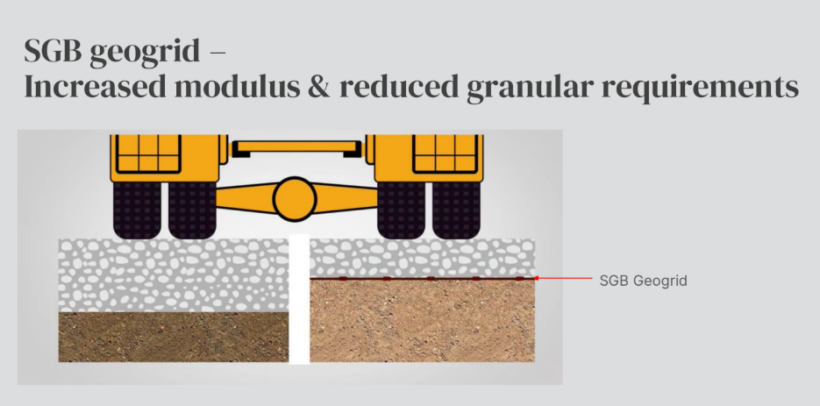
The subgrade is the natural soil or compacted fill that forms the foundation for the entire pavement structure. It is prepared and compacted to provide a stable base on which the overlying layers are built. A subbase layer, if used, is placed on top of the subgrade. The strength and load-bearing capacity of the subgrade are critical factors that determine the performance and durability of the overlying pavement structure. Weak subgrade conditions result in the rutting of the overlying pavement and thus reduce its lifespan. Hence, it is necessary to test the soil first and take proper measures to strengthen the soil quality before constructing a pavement. Materials like geogrids and geocells, which are geosynthetic, serve as effective solutions for enhancing subgrade soil, often selected based on site specifications and engineering designs.
Base course:
The base course is a layer of material placed above the subgrade, or above the subbase if one is present. It serves as a primary structural layer, giving a stable base for the upper courses and passing loads to the subgrade. The strength and stability of the base course are vital to the pavement’s performance.
Binder course:
The binder course is a layer of bituminous material located between the base course and the wearing course. The binder course contributes significantly to strength and fatigue resistance, working with the base course to carry structural loads. The binder course has a coarser gradation that improves stiffness and distributes fatigue stresses. Its primary function is structural; it distributes the heavy loads from the wearing course down to the base course. Made with coarser aggregates than the surface layer, the binder course provides much of the asphalt structure’s strength and fatigue resistance, and it supports the wearing course over the base layers.
Wearing course:
The top course, the wearing course of the pavement, comes in direct contact with the traffic and seals the surface. It is mainly constructed out of asphalt or concrete, which is selected depending on factors like expected traffic loads, environmental conditions, and maintenance considerations.
The top layer of the road, known as the wearing course, is important because it needs to last a long time and help vehicles grip the surface safely. The choice of material depends on how busy the road is, the climate in the area, and the desired appearance of the road. This ensures drivers have a safer and smoother ride. Asphalt is often selected for highways and residential roads, while concrete is commonly used in high-traffic zones such as airport runways and central boulevards.
What factors influence road pavement design?
The road pavement design process is a multilateral approach that carefully considers different variables. These variables can significantly affect pavement performance, durability, and long-term maintenance costs.
Volume:
Vehicle volume, usually expressed in terms of cumulative Equivalent Standard Axle Loads (ESALs) over the design life, plays a key role in pavement design. Higher traffic demands greater thickness and stronger materials to ensure long-term performance.
Weight:
Vehicle weight, especially that of heavy trucks, is a crucial attribute. These trucks put more pressure on the pavement, and thus, the pavement structure must be designed to be stronger, which may involve increasing layer thicknesses or using higher-quality materials.
Climate:
The pavement response is influenced by the variable thermal conditions exhibited by extreme temperatures, the presence of precipitation, and freeze-thaw conditions.
Climate-induced stresses significantly impact asphalt pavement behaviour; elevated temperatures induce asphalt softening, often resulting in permanent deformations such as rutting, while low temperatures may precipitate frost heave and thermal cracking. Pavement engineers must duly account for these climatic variables to ensure robust performance and durability across varying environmental conditions.
Soil type:
Subgrade soil attributes, notably strength, moisture regime and frost susceptibility, are integral to pavement design. Unsuitable or unstabilised soils require supplemental layers or specific treatments to furnish adequate support, thereby underpinning pavement structural viability.
Drainage:
Proper drainage stops water from seeping into and accumulating within pavement layers, where it can cause damage. Features like ditches, culverts, and subdrains are installed to guide or divert water away.
Life cycle cost analysis:
This approach considers more than just the initial construction cost. It evaluates the entire life cycle of a pavement—construction, maintenance, rehabilitation, and sometimes user costs—over its service life. This helps determine the most cost-effective option in the long run.
Geographical situations:
Land topography, current infrastructure, and utility locations can influence the planned pavement. For instance, steep slopes may require erosion protection. Underground utilities may also limit how deep you can get with the excavation.
Budget:
The available budget is one of the main factors guiding pavement design. It influences material selection, layer thickness, and even the extent of the project. Within budget constraints, the designer must develop a pavement that satisfies performance and service-life requirements.
Material Availability and Cost:
The choice of pavement design often depends on the availability and cost of local materials. In regions where premium aggregates or binders are too expensive or hard to source, engineers may adjust the design either by using substitutes or relying more on locally available materials to make the project practical and economical while maintaining performance.
What are the different ways of designing road pavements?
Pavement design involves identifying the appropriate amount of materials and level of thickness required to create a durable and functional roadway. Several methods are used to accomplish this, each with its own specific benefits and drawbacks.
Empirical methods:
This approach uses historical data and prior experience to develop the pavement design. Usually, simple formulas or charts are applied, relying on two main factors: traffic load and the environmental conditions surrounding the pavement.
These methods are easy to apply and don’t call for much data, which is why they’re often used. The drawback is that they don’t always give reliable results—especially when the pavement structure is complicated or the site conditions are unusual.
Mechanistic-empirical models:
These methods employ the theories of pavement mechanics together with empirical evidence. They investigate the stresses, strains, and deflections in the pavement structure due to the different loads. These methods offer greater reliability, particularly for complex designs, but require more data and computational resources.
FEA (Finite Element Analysis):
It is a computational method that is used to numerically solve complex engineering problems by dividing the structure into a mesh of smaller elements. This method divides the pavement into small parts and calculates the stresses and strains in each section.
Although FEA can handle complex pavement shapes and loads with good accuracy, it is mostly used for research or special cases. Regular pavement design usually relies on mechanistic empirical methods, which are simpler and more practical for routine use
Using geosynthetic materials in road pavement construction
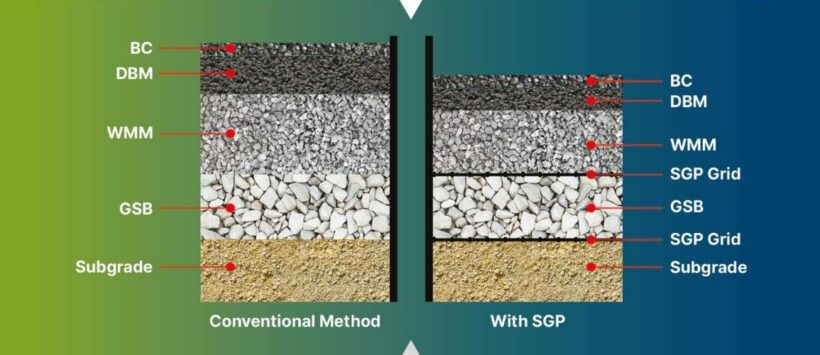
Durable, stable materials are essential in road pavement construction, especially with rising traffic demands. Geosynthetics such as geogrids, geotextiles, and geocells are now widely used as integral elements in modern pavement design.
Primary functions of geosynthetics for pavement performance
Soil reinforcement:
Geosynthetics such as geogrids and geocells are installed within the subgrade, at the subgrade–subbase interface, or inside base/subbase layers to add strength. The materials interlock with soil or aggregate particles, forming a composite that resists deformation under load.
Prevention of lateral movement:
Geosynthetics also restrict lateral movement of aggregate or subgrade material, helping to maintain structural integrity and prevent problems such as rutting or bearing capacity failure.
Confining the soil or aggregate within an area, these geosynthetics maintain subgrade or layer integrity and hence provide a stable foundation to the pavement layers above.
Separation:
Geotextiles separate the fine-grained subgrade from the granular base course. This prevents mixing under load and helps the base layer retain both its strength and drainage capacity.
Filtration:
In drainage contexts, geotextiles function as filters, permitting water to enter a drainage system while stopping fine soil particles from obstructing it. This manages water within the pavement system and maintains subgrade stability.
Benefits of Geosynthetics in Pavement
Increased pavement lifespan:
Geosynthetics prevent or minimize pavement deformation and deterioration by improving structural capacity, reducing stress on underlying layers, and maintaining layer integrity, thereby enhancing the overall distribution of load and mitigating distress.
Reduced material and labor costs:
Geosynthetic reinforcement allows the pavement layers to be made thinner because it reinforces the subgrade and distributes loads more effectively. This reduction in thickness can result in significant savings in construction materials and labor costs and, therefore, make geosynthetics cost-effective for modern pavement design.
Sustainability:
Geosynthetics improve pavement durability and longevity, which reduces the frequency of repairs and reconstruction. With lower maintenance cycles, and reduced overall costs for building (through use of local infill materials, reduced compaction needs, and lower raw material inputs), geosynthetic use also brings down the net resource requirement for a pavement project.
Resource efficiency:
Geosynthetics reduce pavement layer thickness by lowering the demand for aggregate, asphalt, or concrete. This saves cost and lessens the environmental impact of construction.
Adaptability to various conditions:
These materials easily adapt to the different soil and pavement types. Whether applied on flexible pavements, rigid pavements, or composite pavements, geosynthetics provide a dependable solution for performance improvement and durability in diverse applications.
Even load distribution:
By spreading the loads over a larger area, geosynthetics reduce stress concentrations on the subgrade and lower layers. This even distribution prevents localized failures—such as rutting or cracking—which occur when heavy traffic loads are concentrated on specific points.
Success story of Strata: Construction of internal township road with StrataWeb® for Emami
Location: Jhansi, Uttar Pradesh, India
Client: Emami Developers, Kolkata
Product used: StrataWeb® 330-100
Application: Concrete road construction
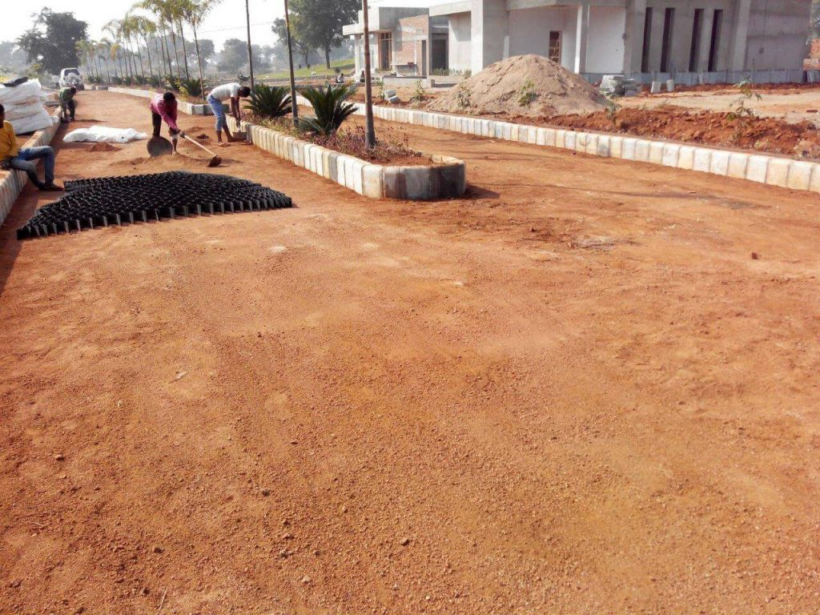
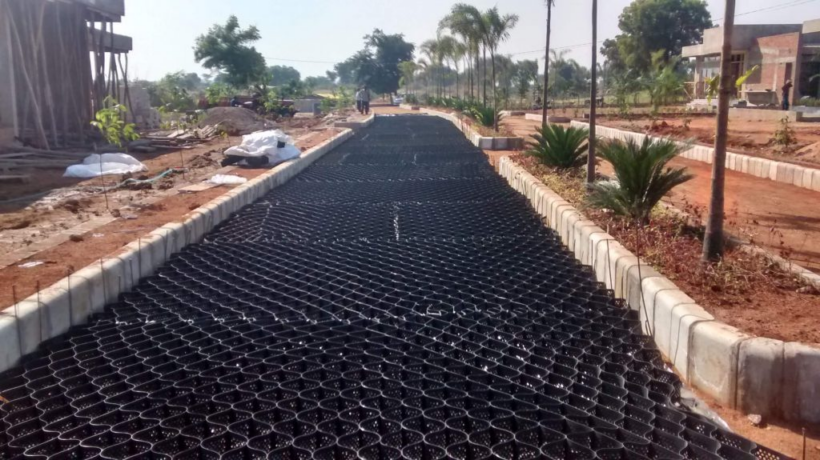
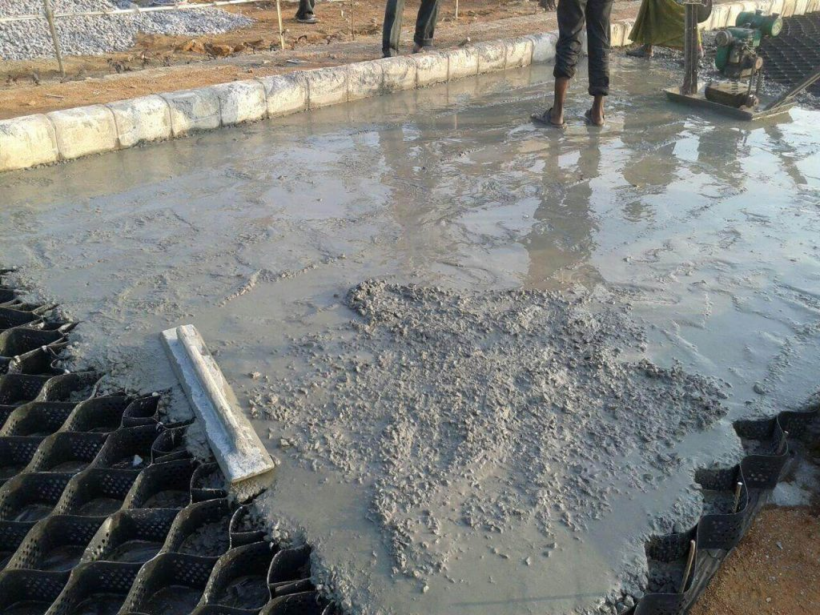
Construction of internal township road with StrataWeb® geocells for Emami
Emami Developers initiated a large residential township project near Jhansi, featuring around 20 km of internal roads. The initial plan for conventional concrete roads was found to be too costly. Strata Geosystems proposed using StrataWeb 330-100 geocells filled with M20 concrete.
This solution lowered costs while extending the roads’ lifespan. Geocells created a durable, low-maintenance structure that limited surface cracking and enhanced pavement quality. The use of StrataWeb resulted in cost-effective, durable roads with a high-quality finish. They helped control cracking and provided a durable, semi-rigid pavement surface, demonstrating the effectiveness of StrataWeb in road construction.
Strata Geosystems focuses not only on the technical performance of pavements but also on sustainability and cost-efficiency. Through various case studies, the company demonstrates how its geosynthetic solutions, including StrataWeb and StrataGrid, deliver innovative and economical answers to a wide range of pavement construction challenges.
By choosing us for your next project, you can benefit from durable, sustainable, and high-performance pavement solutions that stand the test of time. For more information on how Strata Geosystems can improve your pavement projects, contact us or visit our website today.
FAQs
Pavements come in three main types: flexible (asphalt), rigid (concrete), and composite. These suit different traffic, loads, and environments for roads, airports, and other infrastructure.
Empirical methods (like AASHTO), mechanistic-empirical methods, and FEA (Finite Element Analysis) are key approaches for pavement design.
